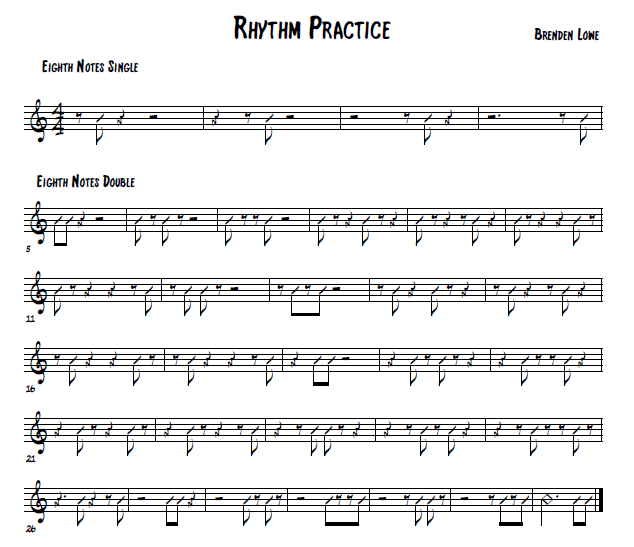One of my students recently asked me a great question about how to approach exploring rhythmic concepts to incorporate into his playing. Although he has played classical music for many years, he started taking jazz lessons with me about 2 years ago, and has just recently played his first gig and a couple more after that. I’m extremely proud of the work he has made and he should serve as an example of someone who has created time to practice and make progress. During the time he first started with me he was in the middle of writing his thesis paper for tenure at Davis University as an economics professor! Wow! This makes full time musicians a little faint. Now, if he can set aside time to make progress and get some practice in, then anyone can.
I have used a systematic approach to exploring rhythms for a long time now and I found it works great to implement new rhythms into your comping and soloing. Let me explain it to you.
Exploring rhythmic comping
It’s actually quite easy to begin getting comfortable with unfamiliar rhythms when comping since we all need to worry about the harmonies and chords rather than spontaneously creating new ideas when soloing. You’ll want to pick a tune your very comfortable with harmonically to go through this exercise. Will use a Cmaj7 chord as an example.
We need to become comfortable with all divisions of each beat within any part of the bar. Do you just go “huh?” What I mean is, we need to be comfortable placing our comp on any beat anywhere in the bar. That’s better. In order to do this we will practice playing on every beat possible. I will only subdivide a couple of times as 32nd notes start to form many, many possibilities.
Quarter Note Comping (Single)
I’m assuming you can hit half notes pretty easily so I’ve decided to start with quarter notes for you. We are simply going to go through all the possibilities that a quarter note allows us to play by itself. We can play on beat 1, beat 2 , beat 3 or beat 4. Set the metronome on to a comfortable tempo, (100 bpm maybe) and begin practicing your Cmaj7 chord on beat 1. Easy peasy I get it. It’ll get harder I promise. Now do beat 2. Now beat 3, now beat 4.

Quarter note Comping (Double)
Now that we’ve done single note comps we will add in another quarter note. Will start with beat 1 and 2. Do you like math? This is the best way to make sure you practice all possible combinations with all rhythms in order to get comfortable. Pick and choose as you want.
After doing beat 1 and 2 we simply do beat 1 and 3 then 1 and 4. You get the picture right? We are applying a little bit of math to our rhythms in order to get every possible combination.

How to practice this system?
I would recommend tackling a couple of these a day. Not all of them in one day. When you have your three measures for the day you’re going to want to practice these a couple of ways.
#1 Different Tempos
Use a metronome to practice with all different tempos. And when I mean lots of different tempos I mean every 4 beats or so. Go from 40 to 44 to 48 and so on. Even 4 beats is going to create a different feel for each of these rhythms.
#2 Different Styles
Practicing these rhythms with a different styles will really help you ingrain the rhythm in your playing. Play them with a swing feel, latin feel, funk feel, slow blues feel, shuffle. As many as you know!
#3 Change the chord in the doubles
Funny what changing the chord will do to your rhythmic feel. You could play the same rhythm perfectly over and over with one chord, but try and change the chord in the middle and you might get completely turned around.
Well, if you don’t think I’ve give you enough to work on by now than you might have too much time on your hands. I’ll add the other rhythms to the blog in a part 2 post soon enough. Enjoy!
If You Enjoyed This Post…
I would really appreciate it if you could like our facebook page and or share this post!
[widgets_on_pages id=”3″]
[Tweet “This blog post is great! Check it out. #jazzpiano #jazzpianoschool”]
Feel free to subscribe to our email tips and bonus content. Simply click below.
















4 Responses
Inspired by your econ prof…thanks.JR
Who would have thought? Ha! You’re very welcome.
Thank you for sharing with us!
Thank you very much for this exercice !
I was looking for this kind of approach (objective one) for a long time ;o)